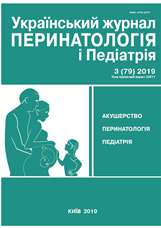Carnitine status in children with chronic kidney disease
DOI:
https://doi.org/10.15574/PP.2019.79.20Keywords:
carnitine status, children, chronic kidney diseaseAbstract
Purpose — to study the metabolic basis of the progression of chronic kidney disease (CKD) in children based on a study of carnitine status, to identify potential candidate markers of CKD progression.Patients and methods. The concentration of acylcarnitines in dry blood spots was determined in 38 children with CKD 2–5 st. aged from 2 to 17 by liquid chromatography tandem mass spectrometry.
Results. Certain metabolic changes were diagnosed in children with CKD 2–5 st. A clear tendency to a decrease in the free carnitine (C0) level begins to be traced at 4 st. CKD in comparison with the values obtained in patients with CKD 2 st. (p<0.05), reaching a minimum in patients with CKD 5 st. (p<0.05). The dynamics of the acetylcarnitine C2 level was wave-like, increasing 1.7 times in patients with CKD 3 st. in comparison with CKD 2 st. (p<0.05), acquiring a tendency to decrease in patients with CKD 4–5 st. When assessing the ratio of acetylcarnitine to free carnitine, a clear increase was observed from 0.47 for CKD 2 st. up to 0.79 with CKD 3 st. and up to 1.05 with CKD 2–5 st. The most indicative was the dynamics of C5DC (glutarylcarnitine) and C6DC (3-methylglutaconylcarnitine), which showed a significant difference in values between all groups of patients, gradually increasing from CKD 2 st. and reaching maximum values in patients with end-stage renal disease.
Conclusions. The metabolic profiling of the carnitine status of the blood allows us to determine a significant relationship between the severity of kidney damage and the level of acylcarnitines in children with CKD. Situations allowing both overproduction and shortages and occurring at the system level have been identified. Potential candidates for CKD progression were identified: acylcarnitines — C5DC (glutarylcarnitine), C6DC (3-methylglutaconylcarnitine). The research was carried out in accordance with the principles of the Helsinki Declaration. The study protocol was approved by the Local Ethics Committee of Kyiv City Children's Clinical Hospital No. 1. The informed consent of the patient was obtained for conducting the studies. No conflict of interest were declared by the authors.
No conflict of interest were declared by the authors.
References
Kostyushina IS, Komarova OV, Mazo AM et al. (2013). Role of central hemodynamic parameters, intimal medial thickness and endothelial dysfunction in children with renal arterial hypertension. Pediatric pharmacology. 10 (3): 32—37. https://doi.org/10.15690/pf.v10i3.695
Sivtseva EM. (2011). Role of endothelial dysfunction in the progression of chronic kidney diseases in children. Rossiyskiy Vestnik Perinatologii i Pediatrii (Russian Bulletin of Perinatology and Pediatrics). 1: 47—53.
Smirnov IE, Kucherenko AG, Komarova OV. (2014). Biomarkers of the formation of nephrosclerosis in chronic kidney disease in children. Russian Pediatric Journal. 17 (6): 10—15.
Hogas SM, Voroneanu L, Serban DN et al. (2010). Methods and potential biomarkers for the evaluation of endothelial dysfunction in chronic kidney disease: a critical approach. Journal of the American Society of Hypertension. 4 (3): 116—127. https://doi.org/10.1016/j.jash.2010.03.008; PMid:20470996
Heringer J, Boy N, Burgard P et al. (2015). Newborn screening for glutaric aciduria type I: benefits and limitations. Int J Neonatal Screen. 1 (2): 57—68. https://doi.org/10.3390/ijns1020057
Kidney Disease: Improving Global Outcomes (KDIGO) СKD Work Group. KDIGO 2012. (2013). Clinical Practice Guideline for the Evaluation and Management of Chronic Kidney Disease. Kidney Inter. Suppl. 3: 1—150.
Kolker S, Christensen E, Leonard JV et al. (2011). Diagnosis and management of glutaric aciduria type I — revised recommendations. J Inherit Metab Dis. 34 (3): 677—694. https://doi.org/10.1007/s10545-011-9289-5; PMid:21431622 PMCid:PMC3109243
Lundin U, Weinberger KM. (2018). Towards metabolic biomarkers for the diagnosis and prognosis of CKD. URL: https://www.intechopen.com/books/advances-in-nephropathy/towards-metabolic-biomarkers-for-the-diagnosis-and-prognosis-of-ckd. https://doi.org/10.5772/intechopen.80335
Matsumoto M, Awano H, Bo R et al. (2018). Renal insufficiency mimicking glutaric acidemia type 1 on newborn screening. Pediatr Int. 60 (1): 67—69. https://doi.org/10.1111/ped.13438; PMid:29059480
Miyamoto Y, Miyazaki T, Honda A et al. (2016). Retention of acetylcarnitine in chronic kidney disease causes insulin resistance in skeletal muscle. J Clin Biochem Nutr. 59 (3): 199—206. https://doi.org/10.3164/jcbn.15-146; PMid:27895387 PMCid:PMC5110933
National Kidney Foundation. (2002). K/DOQI clinical practice guidelines for chronic kidney diseases: evaluation, classification and stratification. Am J Kidney Dis. 39 (1): 17—31.
Noone D, Licht C. (2014). Chronic kidney disease: a new look at pathogenetic mechanisms and treatment options. Pediatric Nephrology. 29 (5): 779—792. https://doi.org/10.1007/s00467-013-2436-5; PMid:23471475
Downloads
Issue
Section
License
The policy of the Journal “Ukrainian Journal of Perinatology and Pediatrics” is compatible with the vast majority of funders' of open access and self-archiving policies. The journal provides immediate open access route being convinced that everyone – not only scientists - can benefit from research results, and publishes articles exclusively under open access distribution, with a Creative Commons Attribution-Noncommercial 4.0 international license(СС BY-NC).
Authors transfer the copyright to the Journal “MODERN PEDIATRICS. UKRAINE” when the manuscript is accepted for publication. Authors declare that this manuscript has not been published nor is under simultaneous consideration for publication elsewhere. After publication, the articles become freely available on-line to the public.
Readers have the right to use, distribute, and reproduce articles in any medium, provided the articles and the journal are properly cited.
The use of published materials for commercial purposes is strongly prohibited.

